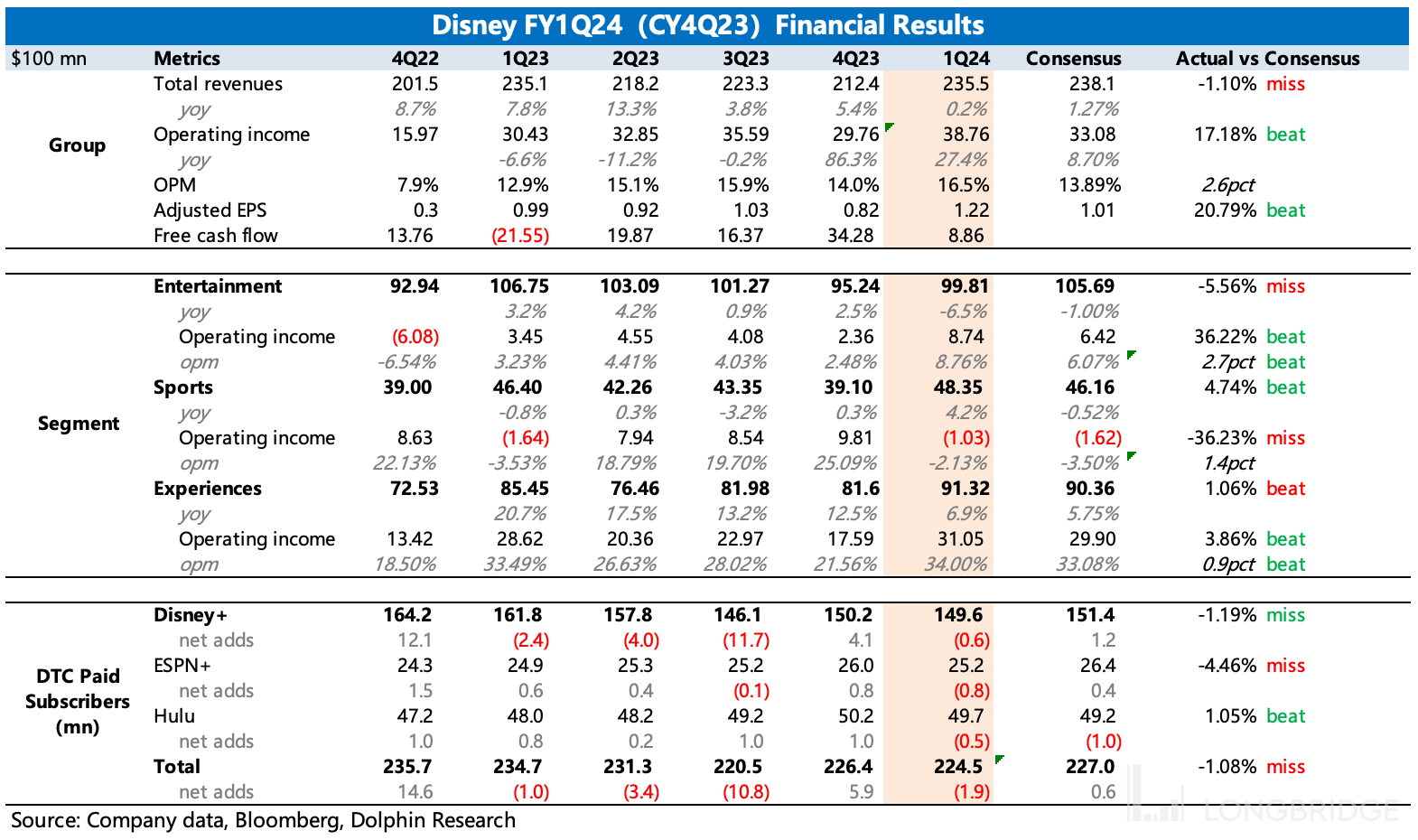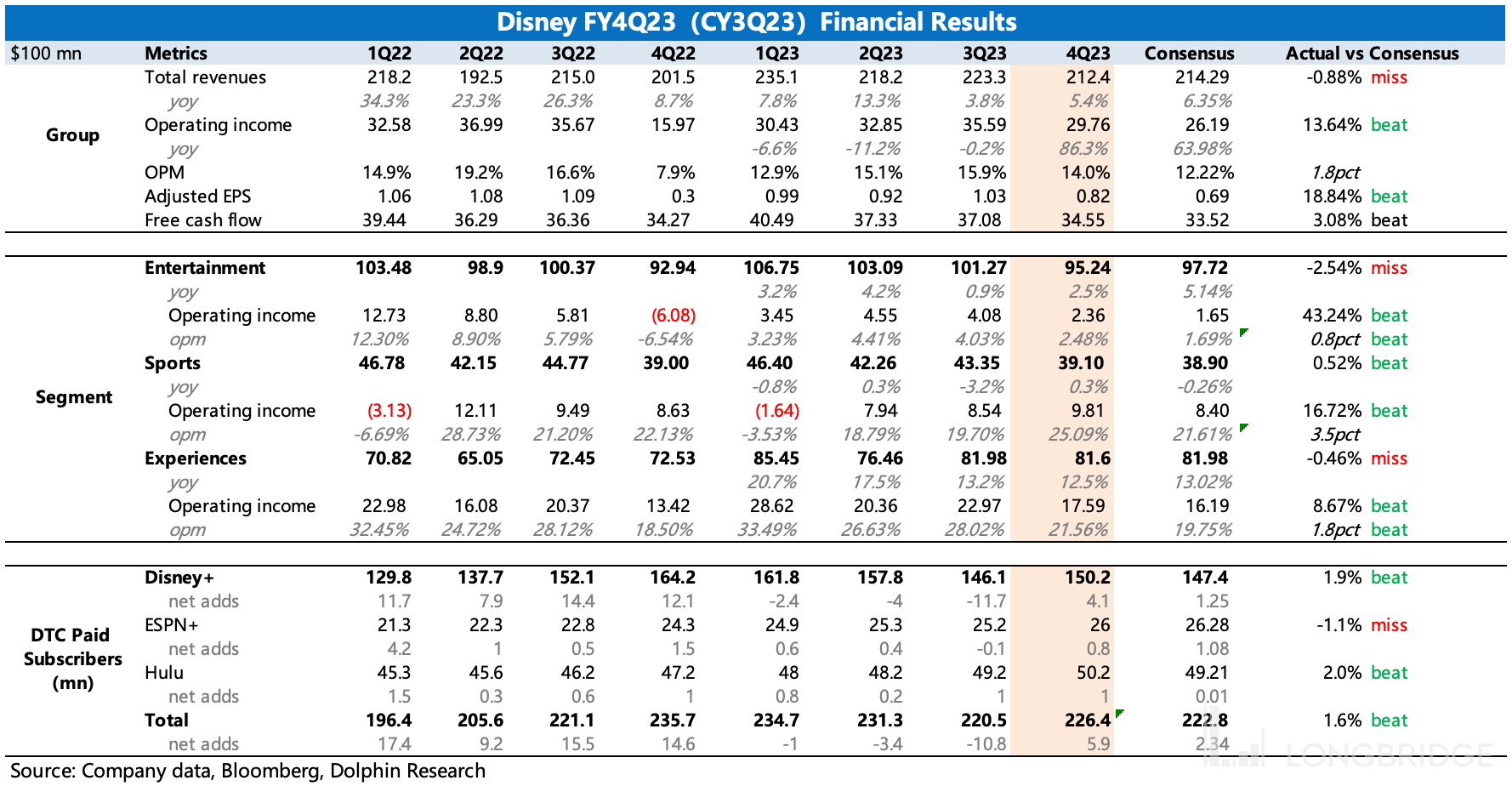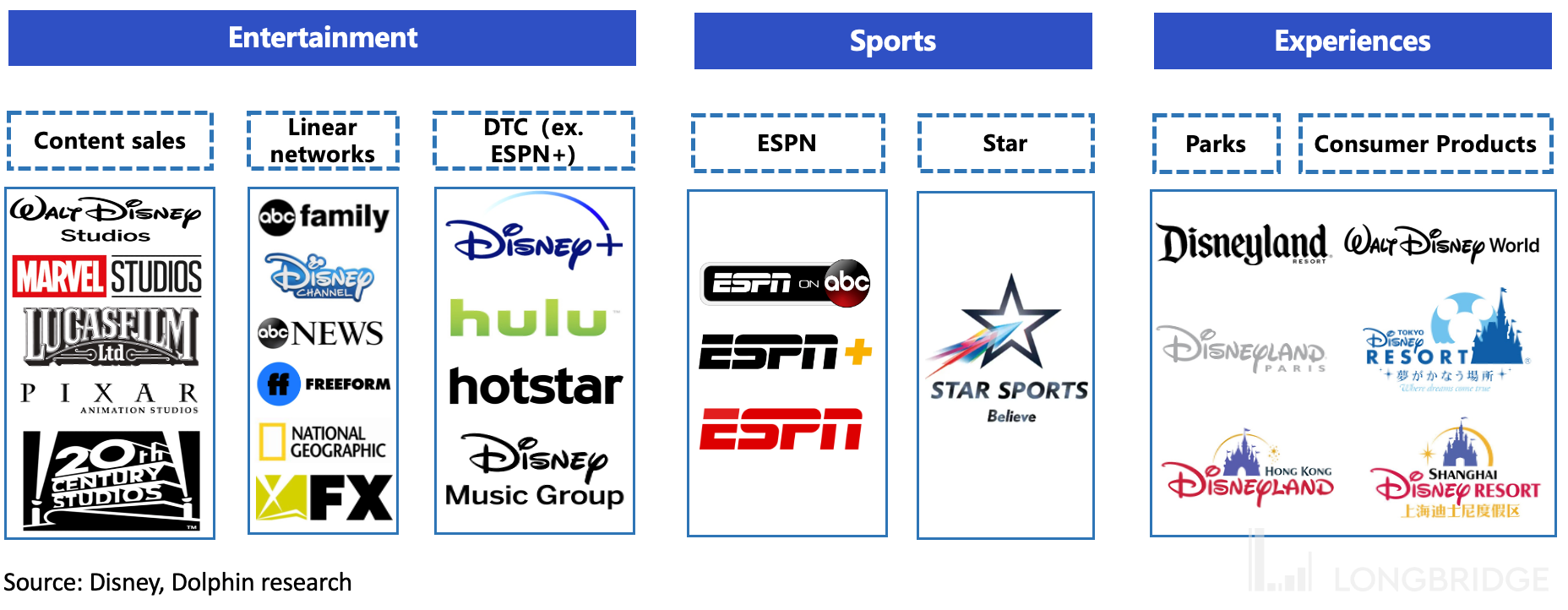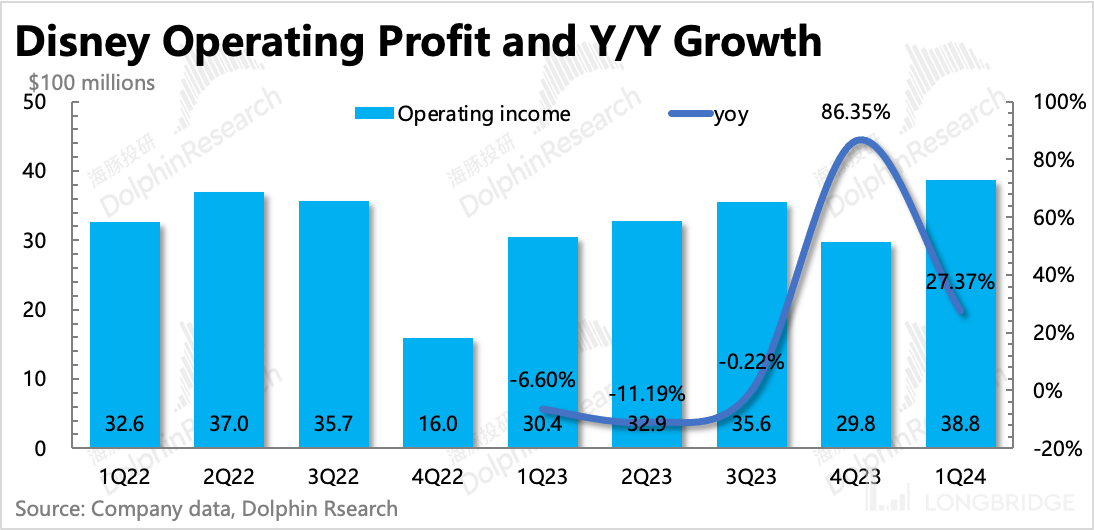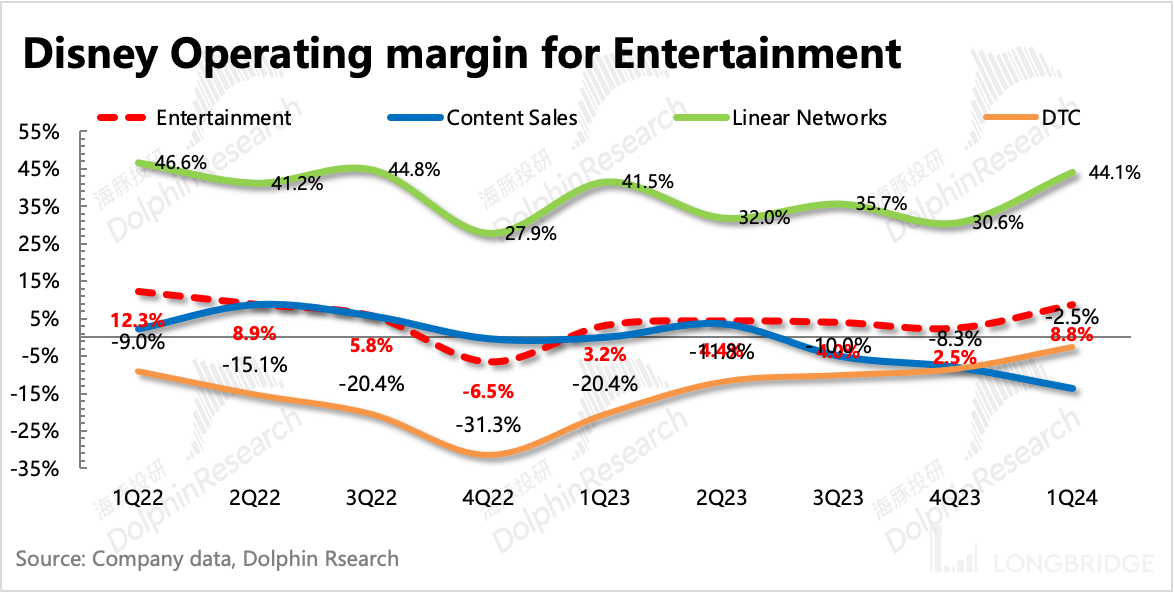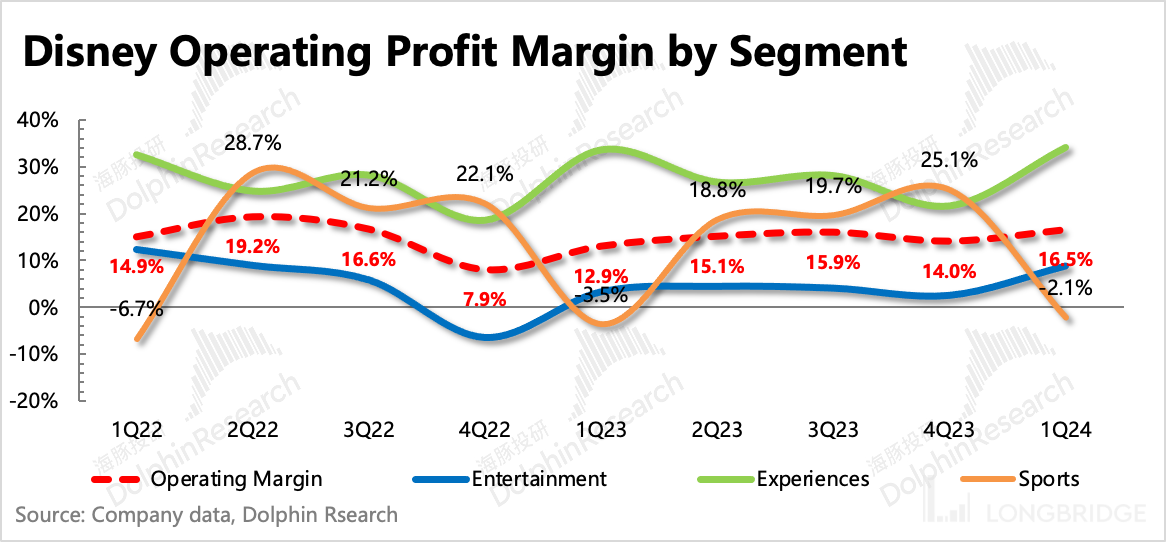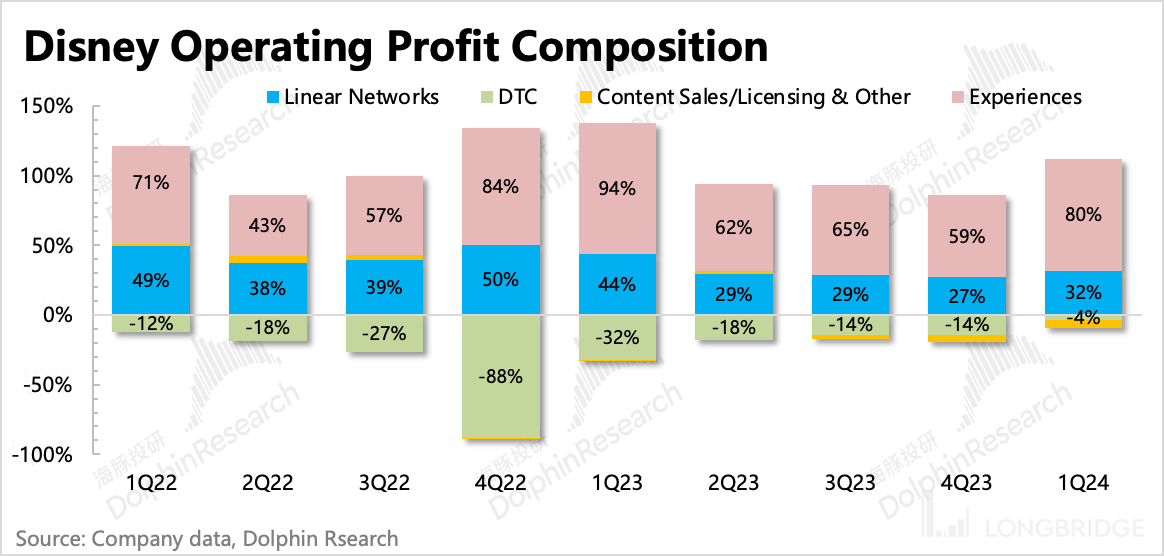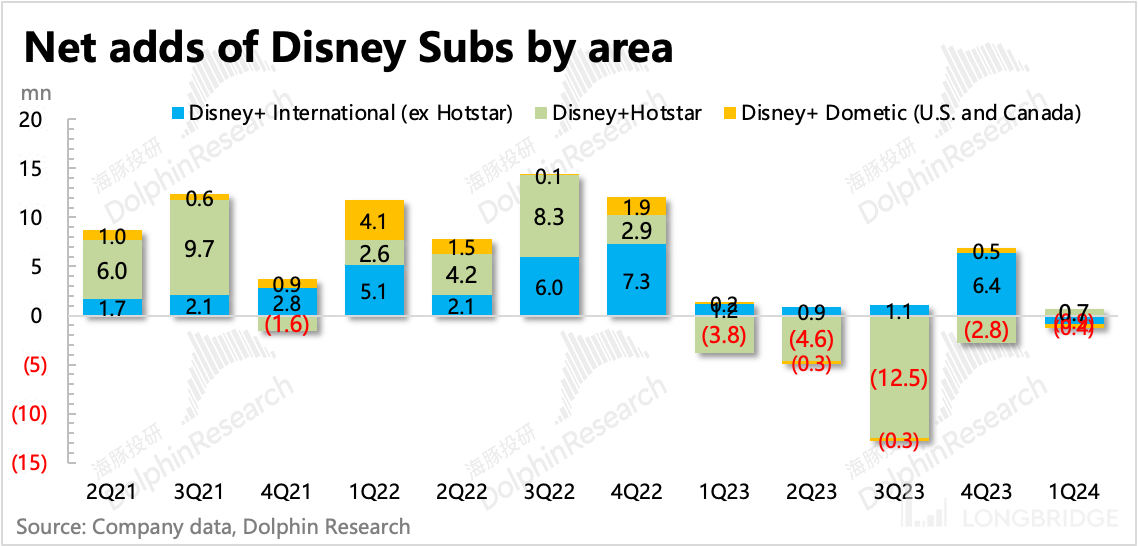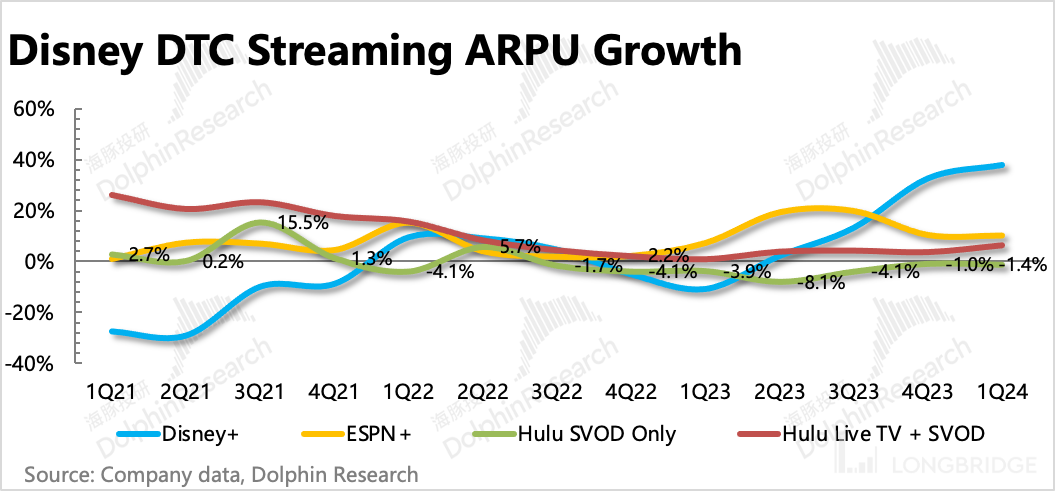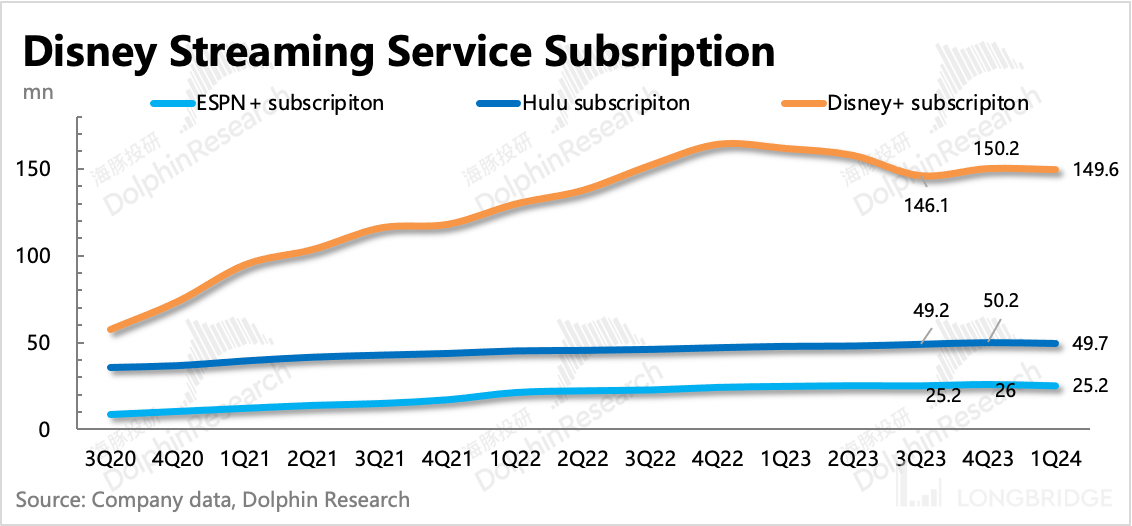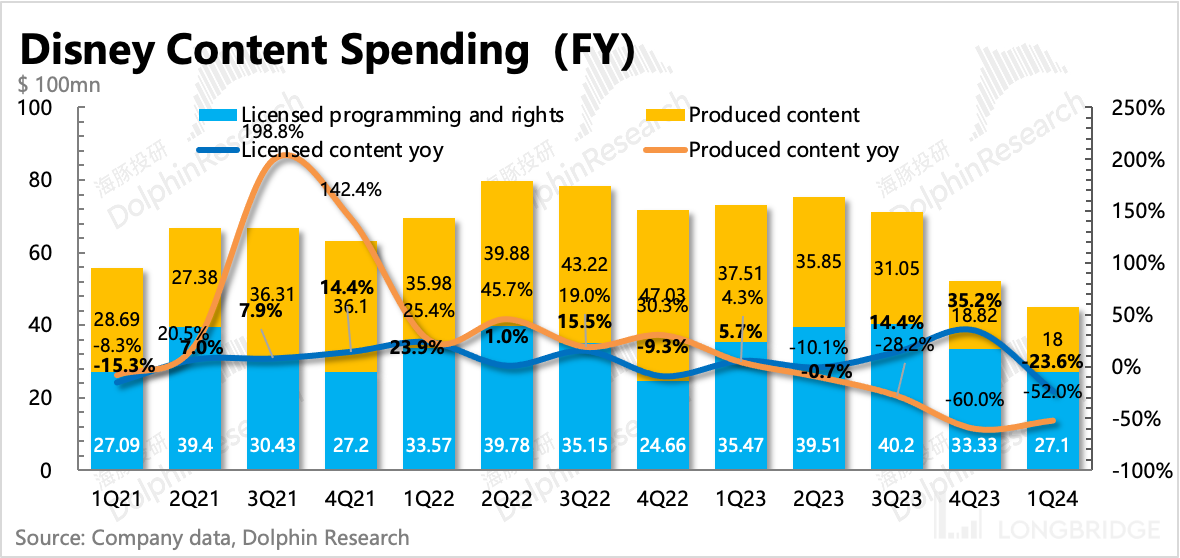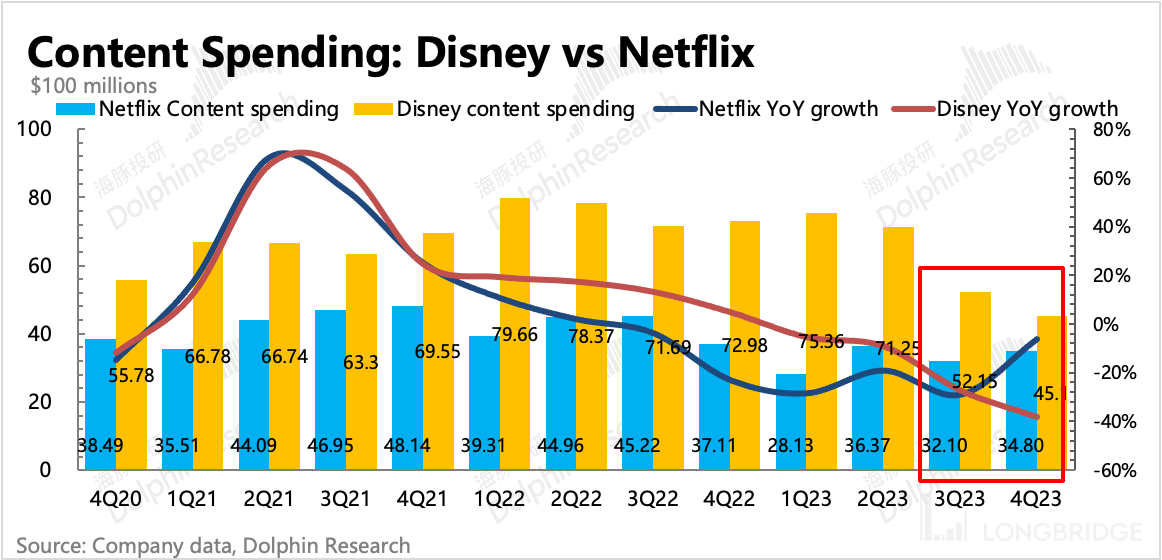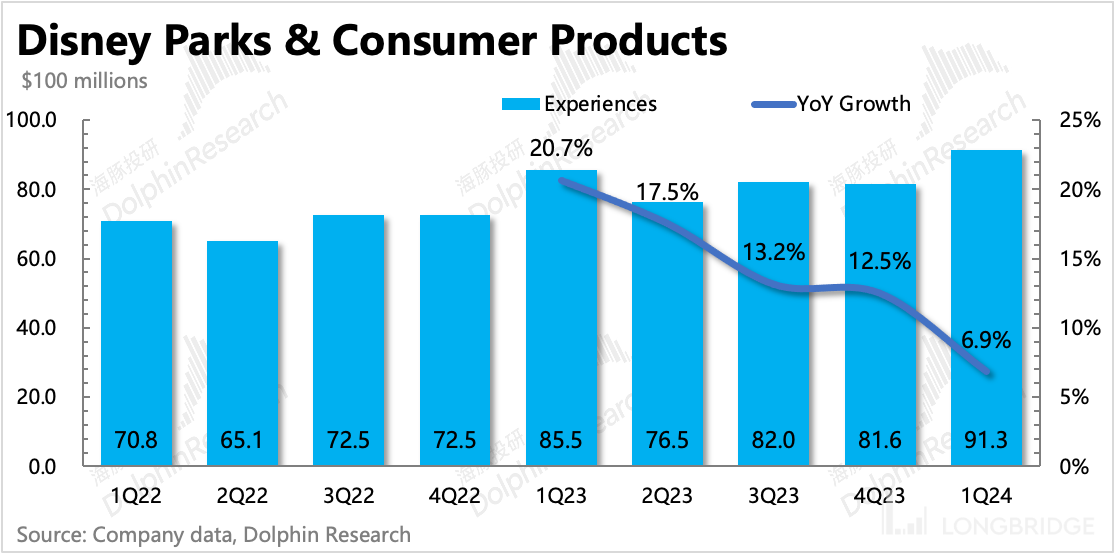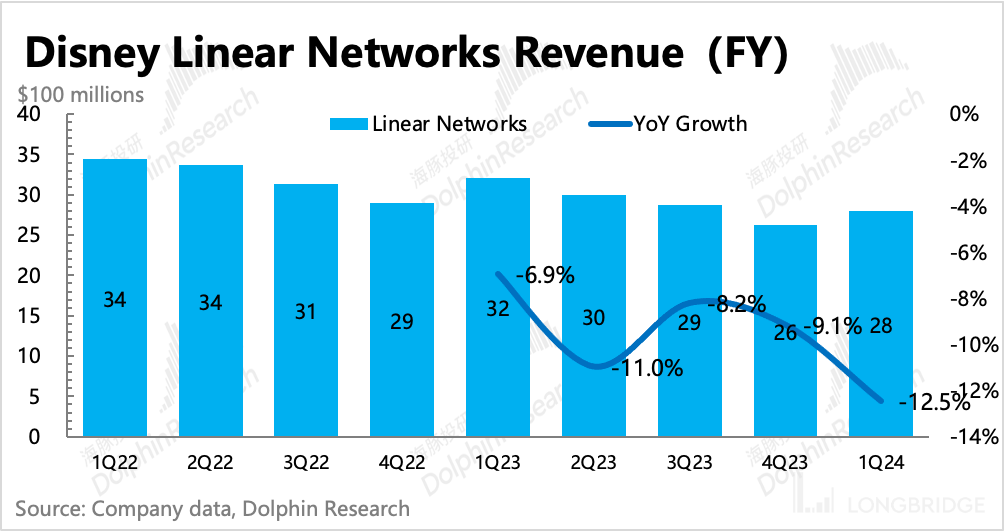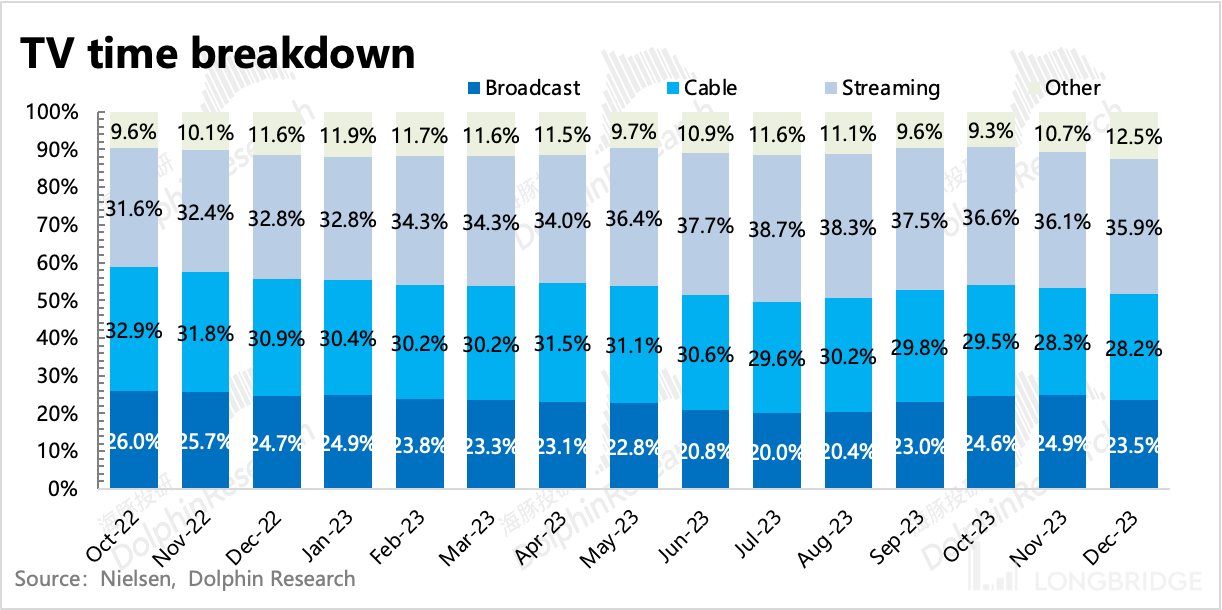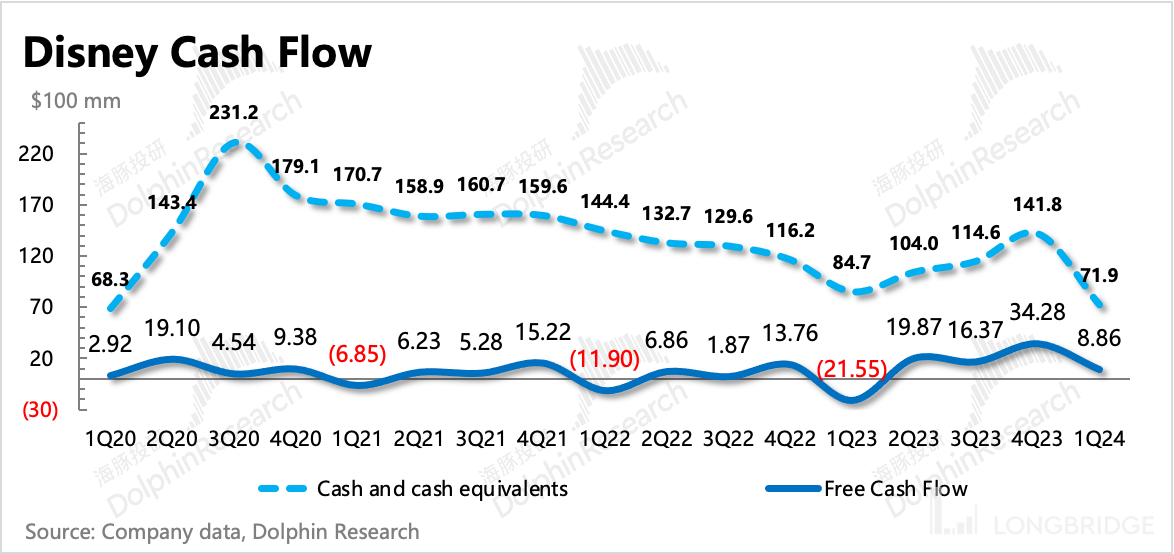
 Likes Received
Likes Received Posts
PostsDisney: Still experiencing labor pains, but a turnaround is on the way.

Hello everyone, I am Dolphin Research!
On February 7th, Disney released its financial results for the first quarter of the 2024 fiscal year (CY23Q4) after the US stock market closed. Similar to the previous quarter, Disney is still focusing on "improving profitability," but the performance of its revenue is mixed, and even missed overall.
However, this does not prevent the market from interpreting the earnings report positively. Dolphin Research believes that there are two main factors contributing to this:
(1) Investor preference: After more than a year of the streaming media bubble, most of Disney's remaining investors are value investors who focus on real earnings. Therefore, the short-term strategy of sacrificing growth for profit actually aligns with investors' expectations.
(2) Optimistic guidance: The management's guidance for the 2024 fiscal year in this earnings report has released multiple positive signals (including growth expectations for streaming media, group profit targets, buyback plans, and broader and deeper strategic cooperation), further boosting investors' confidence in Disney's growth after going through a period of pain.
Specifically:
- Surprisingly high profitability: The "profit indicator" that most Disney investors are currently concerned about continues to bring surprises in the first quarter. The group's Adj. EPS reached $1.22, significantly higher than the market's expected $1.01, showing significant improvement both YoY and MoM.
However, the improvement in profitability in the first quarter mainly came from the reduction in various expenses:
(1) Despite a 40% YoY decrease in overall content investment, costs decreased by 6%, resulting in an additional $800 million in gross profit.
(2) Other operating expenses such as sales and management were also reduced by $500 million compared to the original budget, with a YoY contraction of over $100 million.
The company's profit guidance for the 2024 fiscal year once again exceeded market expectations, with an expected EPS of $4.6, while the consensus estimate was $4.3.
- Revenue is still under pressure, but growth prospects are seen in the guidance: In the first quarter, Disney's revenue side is still under pressure. Although the growth rate of the park business has slowed down significantly due to the marginal decline in domestic popularity, it is still the performance leader within the group. The sports business, mainly ESPN, has also returned to growth in the first quarter.
However, the entertainment business is still struggling. In terms of segmentation, streaming media has maintained a good growth rate due to price increases and the addition of advertising monetization through Disney+. However, traditional cable channels and film sales are dragging down overall performance.
Fortunately, the company has provided some positive guidance for the growth of DTC streaming media (excluding ESPN) in 2024, especially mentioning a target of 5.5-6 million net user additions. This is the first time in three consecutive quarters that the management has mentioned user targets again, indicating a signal that the group will resume normal investment and growth operations after restructuring and adjustment.In addition, although the company's content investment in the first quarter was very low, the guidance for the whole year of 25 billion yuan is not significantly lower than last year's 27 billion yuan, and the difference is mainly due to the impact of strikes. With this investment scale, it is expected that the investment will increase rapidly starting from the second quarter. Therefore, there is no need to worry too much about the compression of investment affecting the content output in the future.
- Continuous improvement in cash flow, additional 3 billion yuan for repurchase: After more than a year of internal restructuring, the trend of continuous improvement in cash flow is also evident under the improvement of cost reduction and efficiency enhancement. The free cash flow in the first quarter was nearly 900 million yuan, an increase of 3 billion yuan compared to the same period last year.
After accumulating cash on the group's balance sheet, 8.6 billion yuan was used in the first quarter to acquire the remaining 33% equity from Comcast, and an additional 3 billion yuan repurchase plan was announced. In addition, the interim dividend for this half-year increased by 50% compared to the amount distributed in January, reaching $0.45 per share.
For the cash flow expectations for 2024, the company also provided a relatively clear guidance, believing that it can increase by 60% and achieve a total annual free cash flow of 8 billion yuan.
- Strategic cooperation inside and outside the industry: Since last year, Disney has shown signs of expanding cooperation with external partners due to the need to reduce costs and increase efficiency and increase external procurement and authorization in content investment.
This time, Disney not only announced the launch of sports streaming media in collaboration with its subsidiary Fox and Warner Bros., but also announced a $1.5 billion investment in Epic to deepen their cooperation. Previously, Disney's Marvel IP was authorized to be integrated into "Fortnite".
Performance indicators at a glance

Dolphin Research's viewpoint
"'Sacrifice growth for profit' is the core point of Iger's business restructuring after taking over the mess more than a year ago. Therefore, the main action taken by Iger is to raise prices for advantageous businesses and cut resource investment for loss-making businesses."
"The initial stage of restructuring was very difficult, especially when 'reducing investment in streaming media content and tolerating zero user growth' and 'accelerating the abandonment of traditional cable business' were carried out in parallel, which put great pressure on short-term performance and relied on the park business to barely support it during the economic cycle. However, it also squeezed out funds that valued growth and left behind multiple funds that favored stable profits and dividends, while also betting on value investment funds that expected a turnaround in difficulties."
Although Disney has rebounded from over 140 billion yuan to 180 billion yuan (after-hours gains have exceeded 190 billion yuan), which is in line with Dolphin Research's bottom valuation (130-150 billion yuan) and trend judgment (either confirm the reversal pace based on the first quarter performance or find opportunities around pessimistic valuation), it cannot be ignored that such a rapid short-term increase also includes the premium brought by loose market liquidity.From the revenue perspective, the pain period for Disney has not completely ended. Dolphin Research still expects that in the first half of the year, there may continue to be a content supply gap affecting film sales and the impact of a high base on theme parks.
As for the significant proportion of traditional cable channel business, can the transition to streaming media be successful? Will there be a loss of market share? These are potential risks that undermine the fundamental logic. This is also why most investors still do not find Disney attractive enough for investment until they see a trend stabilizing.
Therefore, Dolphin Research believes that the increase in stock price before this earnings report is more of a recognition of Disney's improvement in efficiency during this restructuring phase, rather than a reversal of its predicament. The real signs of reversal appear in this earnings report, where management describes and expects how the business will return to a growth cycle through guidance - increasing streaming media prices (to combat sharing, advertising plans, and price hikes), partnering with peers to bet on sports content, investing in Epic to enhance gaming content and improve membership services, as well as expecting high growth in EPS and cash flow. In addition, due to the expansion of the advertising industry budget and the increase in political advertising during the election year, we expect that the pressure on revenue for traditional cable channels this year will be somewhat alleviated due to the low base.
Therefore, similar to the viewpoint from the previous quarter, Dolphin Research believes that Disney is showing a trend of continuous improvement from a marginal perspective, with the only issue being the pace of recovery due to the impact of content supply. However, after going through the most difficult period of restructuring, taking a medium to long-term perspective, we believe that Disney is expected to gradually recover to a neutral valuation of 2.3 trillion yuan (SOTP).

The following is a detailed analysis of the earnings report:
I. Understanding Disney
As an entertainment kingdom that has been around for nearly a century, Disney's business structure has undergone multiple adjustments. Dolphin Research has provided a detailed introduction in the article "Disney: The "Anti-Aging Technique" of a Centenarian Princess".
This major adjustment at the group level not only changed the leadership team but also the business structure and strategic focus. Under the new business structure, it is mainly divided into three major segments: Entertainment, Sports, and Experiences.
- Differences between the old and new business structures?
The new structure highlights the strategic position of ESPN, separating ESPN channels and ESPN+ to establish a sports business division, which shows the company's emphasis.
(1) The Entertainment segment includes: the original cable channels, DTC (excluding ESPN+), and content sales, while disposing of some redundant business lines and low-profit traditional channels during the integration process.(2) The sports business includes ESPN channels, ESPN+, and Star.
(3) The experience business includes park experiences, travel and cruises, and consumer goods. Similar to the previous business, there may be some discrepancies in the specific financial data due to adjustments in the business.
- Has the architecture changed? Has the investment logic changed?
The basic logical framework remains the same, but there are new points of focus.
Firstly, this change in framework reflects an important strategic adjustment - content and distribution channels are no longer separated into two businesses, but integrated together. The new business structure is more based on different types of content.
This may solve a problem at its source - the same content may be suitable for initial release on different channels. The question of whether Disney's popular films should be released on Disney+ or in theaters first in the past two years has affected the performance of many highly anticipated films. As a result, actors have suffered, and it has also damaged Disney's collaboration with some star actors.
The experience business has developed for many years and is relatively mature. With the support of a strong IP reserve, Disney's theme park business maintains a leading position and is more influenced by overall consumer spending. Under normal circumstances, it can be seen as a stable cash flow.
The entertainment business essentially involves the production and distribution of Disney films, including well-known studios, traditional channels, and streaming channels. Therefore, changes in revenue are mainly related to Disney's film scheduling and overall film market consumption.
The streaming media business is still the future focus of Disney in the medium to long term. However, in the past two years, it was originally a growing business that provided incremental revenue and profits while Disney's traditional business remained stable. But the competition in the front-end streaming media has intensified during the pandemic. Disney, without the accumulated advantage of producing original TV series content, has made huge investments but suffered losses.
As a seesaw, while the development of streaming media is booming, traditional media's old business naturally cannot thrive on its own. As traditional media declines, streaming media for Disney is not purely incremental, but rather a large part is compensating for the decline of traditional channels.
Disney's new favorite, the sports business, may be a new growth path that has emerged. Although ESPN has been operating within Disney for many years, sports content and related industries are also entering the sights of more and more streaming media companies. For example, Netflix has mentioned several times their focus on and increased investment in sports content.
The recent change is that Disney will join forces with Warner Bros. and integrate its own Fox content to launch a new version of ESPN in 2025, which is equivalent to doubling down on the bet on the sports track.
 2. Profit Exceeds Expectations from "Cost Cutting"
2. Profit Exceeds Expectations from "Cost Cutting"
Reducing losses in the streaming media sector and improving overall profitability for the group is Iger's top priority upon his return.
The first quarter saw a greater-than-expected reduction in losses in the streaming media sector, with actual losses amounting to 138 million, a significant improvement compared to the 984 million loss from the same period last year. Market expectations were for an operating loss of around 300 million.
The group achieved an operating profit of nearly 4 billion, a year-on-year increase of 27%, with an operating profit margin of 16.5%, a 2.5 percentage point increase compared to the previous quarter and a 4 percentage point increase compared to the same period last year.
Looking ahead, the company plans to continue controlling expenses, with an expected reduction of 7.5 billion in expenses for the fiscal year 2024, and achieve a free cash flow of 8 billion. In addition, EPS is expected to reach $4.6 per share, a nearly 25% increase compared to the previous year.

Breaking down the new architecture, the entertainment business line with DTC (Direct-to-Consumer) operations saw an overall profit margin increase of 5.6 percentage points, despite the drag from film sales, due to price increases and advertising, as well as reduced content spending on cable channels.

The experience business, primarily consisting of parks, saw a profit margin increase to 34% due to strong demand and price increases at Disney World and Disney Cruise. In terms of contribution to overall profits, the experience business is the main driver of profit margin optimization, rebounding to a contribution ratio of 80%.
The sports business, on the other hand, experienced a temporary decline in profit margin due to higher sports content costs in the first quarter and a certain ramp-up period for converting new users.


3. Price Increases Impact User Growth, Advertising Enhances Monetization Value
In the first quarter, Disney+ experienced a net loss of nearly 1 million users in the European and American regions due to the price increase in December, while the Indian region contributed the majority of the growth. However, compared to Netflix, Disney+ had the second-highest number of new quarterly subscribers under the condition of simultaneous price increases, second only to the period of pandemic-driven growth, indicating that high-quality content is the key driver of growth.

 As of the end of this quarter, Disney+ has 149.6 million subscribers, ESPN+ has 25.2 million subscribers, and Hulu has 49.7 million subscribers, totaling 224.5 million subscribers. Although the company's current focus is on streaming media, it still emphasizes the operation of the streaming media business to reduce losses. With the streaming media operating profit margin only in low single digits, reinvesting in user expansion can quickly yield results.
As of the end of this quarter, Disney+ has 149.6 million subscribers, ESPN+ has 25.2 million subscribers, and Hulu has 49.7 million subscribers, totaling 224.5 million subscribers. Although the company's current focus is on streaming media, it still emphasizes the operation of the streaming media business to reduce losses. With the streaming media operating profit margin only in low single digits, reinvesting in user expansion can quickly yield results.
After avoiding discussing user growth targets for three quarters, the company has finally mentioned user growth targets again: it is expected to increase by 5.5-6 million by 2024, while emphasizing that the streaming media business can achieve profitability in the fourth quarter of 2024. The management's budget for content investment this year is 25 billion, which is lower than last year's 27 billion, but still a considerable amount.
However, the content expenditure in the first quarter is less than 5 billion, which means that we may see Disney increase its investment in streaming media content in the second half of next year.
Therefore, if we see Disney experiencing a decline in user subscriptions and a decline in profit margin due to content shortages in the first half of the 2024 fiscal year, there is no need to panic. Any adjustments would actually present another opportunity.
Although Netflix's content investment is also declining, the decline is obvious and has slowed down. The management has provided a content investment plan of 17 billion for 2024, which is a significant increase compared to 14 billion in 2023, indicating that a new investment cycle has begun.
Although Disney's expenditure in the first quarter (4Q23) was very low (affected by strikes), based on the annual budget of 25 billion, it can be inferred that there will be an accelerating trend of investment in the second half of the year.
Fourth, theme parks: domestic slowdown, overseas enthusiasm under the influence of the base.
In the first quarter, the revenue of theme parks and consumer products was 9.13 billion, with a year-on-year growth of 7% under a high base, showing some slowdown. However, in terms of internal structure, the growth rate of the park business was 8.5%, while consumer product sales continued to decline by 1.5%, with a narrowing decline.
The domestic parks have shown a cooling trend since the previous quarter, mainly reflected in the Disneyland park in California, which is mostly due to the base effect. However, the demand for the Florida park (100th anniversary event) and cruises (new routes) remains relatively stable.However, the international theme parks are still thriving, with a YoY revenue growth rate of 34%, mainly due to price increases and the popularity of the Shanghai and Hong Kong international parks. Compared to the same period last year, when there were lockdowns, the parks only operated for 56 days in a quarter, whereas now they are operating for the entire quarter.

V. Cable media facing revolution, a breather in election years
In the first quarter, cable TV revenue declined by 12.5% YoY, with the absence of ESPN sports channels leading to a further decline. In terms of revenue breakdown, advertising revenue decreased by 21% YoY, while subscription revenue decreased by 5.7%, showing relatively more stability. Subscription fees and distribution revenue still have inertia due to payment habits, so the impact of streaming media on cable TV is still lagging behind, but the trend is basically irreversible.
Looking at the industry as a whole, streaming media companies are still penetrating the user market, with Netflix performing the best and implementing measures to combat account sharing and advertising.
The trend of traditional media being revolutionized by streaming media is essentially irreversible. Cable TV only has rigid demand in specific areas, such as political advertising during election periods and sports event advertising controlled by cable operators. Therefore, Dolphin Research predicts that cable TV channels will have a temporary breather this year.

Nielsen data shows that the share of TV users' time spent on cable TV channels has continued to decline since the beginning of the year, with a slight rebound in traditional media share in September due to concentrated sports events. In the medium to long term, cable TV's advertising revenue will continue to be under pressure.

VI. Stable improvement in cash flow
In the first quarter, free cash flow had a net inflow of nearly CNY 900 million, continuing to improve the cash flow situation while maintaining stable profitability and investment. However, due to the acquisition of the remaining 33% stake in Hulu from Comcast for CNY 8.6 billion, the company's cash and short-term investments decreased to CNY 7.2 billion at the end of the first quarter, with short-term investments amounting to CNY 3.1 billion. Although the company has a total of CNY 47.6 billion in long- and short-term borrowings, more than 90% of it is long-term US dollar-denominated notes, so the actual cash flow situation is not bad.
With the management's further emphasis on profitability, there is no need to worry too much about cash flow. The management has also stated that the free cash flow is expected to reach CNY 8 billion in 2024, a YoY increase of 63% compared to 2023.
However, Dolphin Research also frankly states that we hope to see the issue of content shortage resolved, with traditional content businesses such as movies reducing their drag. At the same time, we hope to see a clear expansion trend in streaming media users once the lagging impact of the strike on content supply is alleviated. There have been some positive signs in the fourth quarter, and when the delayed impact of the strike on content supply is relieved, Disney may truly regain its past glory.**

Due to a large amount of operational data not disclosed in the earnings report, it is recommended that everyone pay attention to the complete financial report or directly check the "Deep Data" section on the Longbridge app.
Dolphin Research "Disney" related articles
Earnings Season
November 9, 2023 Conference Call: "Impact of Disney+ Price Increase on User Payments Will Be Reflected in the Next Quarter (Disney 4Q23FY Conference Call Summary)"
November 9, 2023 Financial Report Review: "Disney: Dawn Breaks, But There's Still a Disturbance"
August 10, 2023 Conference Call: "Disney: More Open, More Cost-Saving (3Q23FY Performance Conference Call Summary)"
August 10, 2023 Financial Report Review: "Disney: Where is the Bottom in the 'Crisis' Moment?"
May 11, 2023 Conference Call: "Weakness in Streaming Subscriptions and Advertising May Continue into Q4 (Disney 2Q23 Conference Call Summary)"
May 11, 2023 Financial Report Review: "Disney: Sacrificing Growth for Profit, How to Handle the Dilemma?"
February 9, 2023 Conference Call: "The Future Belongs to Streaming, But It Requires Reasonable Operations (Disney 1Q23FY Conference Call Summary)"
February 9, 2023 Financial Report Review: "The Legend Returns, Disney Begins to Change"On November 9, 2022, a conference call was held titled "Disney: Focusing on Profit, Open Source and Streamlining (4Q22 Conference Call Summary)".
On November 9, 2022, a financial report review was conducted titled "Titans Taking Turns to Hammer, Can Century-old Disney Hold On?".
On August 11, 2022, a conference call was held titled "Disney: Strong Offline Demand, Lowering Long-term Streaming User Guidance (3Q22 Conference Call Summary)".
On August 15, 2022, an article was published titled "Disney: Theme Parks Remain Popular, Streaming Expands Rapidly".
On May 12, 2022, a conference call was held titled "Disney: Strong Content and Park Performance in the Second Half, Lower Content Licensing and Closure of Asian Parks as Negative Factors (2Q22 Conference Call Summary)".
On May 12, 2022, a financial report review was conducted titled "Disney: Accelerating Profit Release in Traditional Business, Striving to Support Streaming".
On February 10, 2022, a conference call was held titled "Gradually Entering the Content Cycle, Management Confident in Growth Targets (Disney Conference Call Summary)".
On February 10, 2022, a financial report review was conducted titled "Disney: Streaming Growth Regains Glory, Theme Parks Even More Impressive".
On November 11, 2021, a conference call was held titled "Disrupted by the Pandemic, Disney's Content Cycle to be Seen in the Second Half of the 2022 Fiscal Year (Conference Call Summary)".
On November 11, 2021, a financial report review was conducted titled "Sluggish Streaming Growth, Disney's Long and Challenging Transformation Journey".In-depth Analysis
June 1, 2022: "Disney: Bursting the Streaming Bubble and Returning to the Theme Park Kingdom"
October 10, 2021: "Disney: The 'Ageless Beauty' of the Centennial Princess"
October 15, 2021: "Can Disney, the Constant Dream Maker, Achieve a 'Dreamy Valuation'?"
Risk Disclosure and Statement for this Article: Dolphin Research Disclaimer and General Disclosure
The copyright of this article belongs to the original author/organization.
The views expressed herein are solely those of the author and do not reflect the stance of the platform. The content is intended for investment reference purposes only and shall not be considered as investment advice. Please contact us if you have any questions or suggestions regarding the content services provided by the platform.

